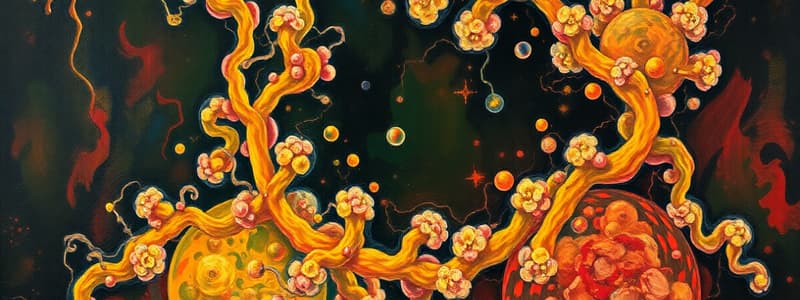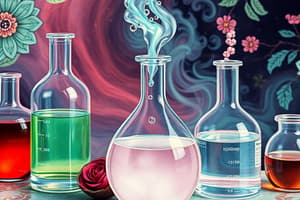Podcast
Questions and Answers
What is the definition of an Acid?
What is the definition of an Acid?
A compound that forms hydrogen ions (H+) in solution
What is the definition of activation energy (Ea)?
What is the definition of activation energy (Ea)?
The initial energy needed to start a chemical reaction
What is the definition of activation site?
What is the definition of activation site?
Specific place where a substrate binds on enzyme
What is the definition of an Amino Acid?
What is the definition of an Amino Acid?
What is the definition of a Buffer?
What is the definition of a Buffer?
What is the definition of Carbohydrates?
What is the definition of Carbohydrates?
What is the definition of a Catalyst?
What is the definition of a Catalyst?
What is the definition of Cellulose?
What is the definition of Cellulose?
What is the definition of a Denatured Enzyme?
What is the definition of a Denatured Enzyme?
What is the definition of an Endothermic or Endergonic reaction?
What is the definition of an Endothermic or Endergonic reaction?
What is the definition of Enzymes?
What is the definition of Enzymes?
What is the definition of an Exothermic or Exogonic reaction?
What is the definition of an Exothermic or Exogonic reaction?
What is the definition of Glycogen?
What is the definition of Glycogen?
What is the definition of Hemoglobin?
What is the definition of Hemoglobin?
What is the definition of Homeostasis?
What is the definition of Homeostasis?
What is the definition of a Hormone?
What is the definition of a Hormone?
What is the definition of the Lock and Key Model?
What is the definition of the Lock and Key Model?
What is the definition of Metabolism?
What is the definition of Metabolism?
What is the definition of a Monosaccharide?
What is the definition of a Monosaccharide?
What is the definition of a Nucleic Acid?
What is the definition of a Nucleic Acid?
What is the definition of a Nucleotide?
What is the definition of a Nucleotide?
A compound is considered organic if it contains carbon.
A compound is considered organic if it contains carbon.
What is the definition of a Peptide Bond?
What is the definition of a Peptide Bond?
What is the definition of pH?
What is the definition of pH?
What is the definition of a Polypeptide?
What is the definition of a Polypeptide?
What is the definition of Polysaccharides?
What is the definition of Polysaccharides?
What is the definition of a Product?
What is the definition of a Product?
What is the definition of a Reactant?
What is the definition of a Reactant?
What is the definition of a Substrate?
What is the definition of a Substrate?
Flashcards
Acid
Acid
compound that forms hydrogen ions (H+) in solution
Activation Energy (Ea)
Activation Energy (Ea)
the initial energy needed to start a chemical reaction
Activation Site
Activation Site
Specific place where a substrate binds on enzyme.
Amino Acid
Amino Acid
Signup and view all the flashcards
Base
Base
Signup and view all the flashcards
Buffer
Buffer
Signup and view all the flashcards
Carbohydrates
Carbohydrates
Signup and view all the flashcards
Catalyst
Catalyst
Signup and view all the flashcards
Cellulose
Cellulose
Signup and view all the flashcards
Denatured Enzyme
Denatured Enzyme
Signup and view all the flashcards
Endothermic Reaction
Endothermic Reaction
Signup and view all the flashcards
Enzymes
Enzymes
Signup and view all the flashcards
Exothermic Reaction
Exothermic Reaction
Signup and view all the flashcards
Glucose
Glucose
Signup and view all the flashcards
Glycogen
Glycogen
Signup and view all the flashcards
Hemoglobin
Hemoglobin
Signup and view all the flashcards
Homeostasis
Homeostasis
Signup and view all the flashcards
Hormone
Hormone
Signup and view all the flashcards
Insulin
Insulin
Signup and view all the flashcards
Lipid
Lipid
Signup and view all the flashcards
Lock and Key Model
Lock and Key Model
Signup and view all the flashcards
Metabolism
Metabolism
Signup and view all the flashcards
Monomer
Monomer
Signup and view all the flashcards
Monosaccharide
Monosaccharide
Signup and view all the flashcards
Nucleic Acid
Nucleic Acid
Signup and view all the flashcards
Nucleotide
Nucleotide
Signup and view all the flashcards
Organic
Organic
Signup and view all the flashcards
Peptide Bond
Peptide Bond
Signup and view all the flashcards
pH
pH
Signup and view all the flashcards
Polymer
Polymer
Signup and view all the flashcards
Polypeptide
Polypeptide
Signup and view all the flashcards
Polysaccharides
Polysaccharides
Signup and view all the flashcards
Product (Output)
Product (Output)
Signup and view all the flashcards
Protein
Protein
Signup and view all the flashcards
Reactant (Input)
Reactant (Input)
Signup and view all the flashcards
Starch
Starch
Signup and view all the flashcards
Substrate
Substrate
Signup and view all the flashcards
Study Notes
Acids and Bases
- Acids release hydrogen ions (H+) in solution
- Bases release hydroxide ions (OH−) in solution
Chemical Reactions
- Activation energy (Ea): The initial energy needed to start a chemical reaction.
- Catalyst: Speeds up the rate of a chemical reaction. Enzymes are biological catalysts.
- Reactants (input): Substances on the left side of a chemical equation.
- Products (output): New substances produced in a chemical reaction.
- Endothermic/Endergonic Reaction: Absorbs heat and energy.
- Exothermic/Exogonic Reaction: Releases heat and energy.
Enzymes
- Enzymes: Biological catalysts that speed up reactions in living organisms.
- Activation site: A specific region on an enzyme where the substrate binds.
- Lock and key model: Describes the precise fit between the enzyme's activation site and the substrate.
- Denatured enzyme: An enzyme that has lost its shape and therefore its function, often due to changes in temperature or pH.
- Substrate: The reactant that an enzyme acts on.
Organic Molecules
- Organic: Refers to molecules that contain carbon.
- Monomer: A small chemical unit that makes up a larger molecule (polymer).
- Polymer: A large molecule made up of many repeating monomers.
- Carbohydrates: Starches and sugars; provide energy.
- Monosaccharide: A single sugar molecule (e.g., glucose, fructose).
- Polysaccharide: Carbohydrates made of more than two monosaccharides (e.g., starch, glycogen, cellulose).
- Proteins: Organic compounds made from amino acids; essential for many bodily functions.
- Amino acid: Building blocks of proteins.
- Peptide bond: Covalent bond that links amino acids together.
- Polypeptide: A chain of amino acids linked by peptide bonds.
- Lipids: Molecules made primarily of carbon and hydrogen; include fats, oils, and waxes.
- Nucleic acids: Macromolecules containing hydrogen, oxygen, nitrogen, carbon, and phosphorus.
- Nucleotide: Monomer of nucleic acids, consisting of sugar, phosphate, and a nitrogenous base.
- Glycogen: Storage form of glucose in animals.
- Starch: Storage form of glucose in plants.
- Cellulose: A structural polysaccharide found in plant cell walls.
- Hemoglobin: Oxygen-carrying protein in red blood cells.
Biological Processes and Regulation
- Metabolism: The sum of all chemical reactions in an organism.
- Homeostasis: The maintenance of a stable internal environment.
- Hormones: Chemical messengers in the body.
- Insulin: A hormone that regulates blood sugar levels.
- Buffer: Solution that resists changes in pH.
- pH: Measure of hydrogen ion concentration.
Studying That Suits You
Use AI to generate personalized quizzes and flashcards to suit your learning preferences.




